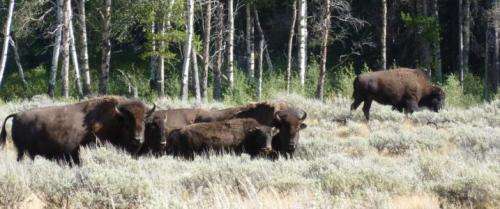Aspen recovering as wildlife populations shift in Yellowstone National Park

Wildlife in Yellowstone National Park is undergoing dramatic shifts with consequences that are beginning to return the landscape to conditions not seen in nearly a century, according to a series of new studies.
In the park's northeast section, elk have decreased in number in their historic winter range in the Lamar Valley and are now more numerous outside the park. This change in elk numbers and distribution can be traced back to the reintroduction of wolves in 1995-96. Scientists have hypothesized that wolves affect both the numbers and the behavior of elk, thereby reducing the impact of browsing on vegetation, a concept known as a "trophic cascade."
Rising grizzly bear numbers are also taking their toll on elk. As a result, lush vegetation is growing back in many but not all areas.
"Without wolves, this would not have happened," said Luke Painter, an instructor at Oregon State University and lead author of three recent papers that describe the results of his fieldwork monitoring vegetation growth patterns in the park. "Wolves caused a fundamental change, but certainly they are interacting with other factors such as bears, climate, fire and human activity."
Bison have also played an important role in the changes in vegetation in northern Yellowstone. Their numbers have increased four-fold as elk have decreased. In places where bison congregate, they browse on aspen, cottonwood and willow, compensating in part for the decline in elk. However, bison cannot reach as high as elk to browse, allowing more trees to escape and grow to maturity.
From 2010-12, hiking in the Yellowstone backcountry, Painter re-measured 87 aspen stands previously studied by his adviser, William Ripple, and former OSU student Eric Larsen in 1997 and 1998. Painter conducted a regional survey of stands across the northern part of the park and also in the Shoshone National Forest west of Yellowstone, where hunting and cattle grazing are allowed.
Painter detailed his findings this summer in an online report in the journal Ecology. He received his Ph.D. in the College of Forestry at Oregon State in 2013 and is now an instructor in OSU's Department of Fisheries and Wildlife.
"This new study illustrates the powerful insights you can get from taking a view over 15 years or more," said Aaron Wirsing, an associate professor of wildlife science at the University of Washington. Wirsing was not involved in Painter's study.
"Wolf reintroduction was a landmark moment, but the changes vary throughout ecosystems as a function of other factors," Wirsing added. "By taking an ecosystem point of view, this paper shows the complexity of the system and all its moving parts."
For much of the 20th century, aspen appeared to be in severe decline. While studies by Ripple and his OSU colleague Robert Beschta pointed to the beginnings of an aspen recovery within a decade of wolf reintroduction, other researchers reported finding little evidence of aspen regrowth. Painter has shown that aspen recovery is widespread over much of the northern range, but where elk are still numerous, aspen stands are heavily browsed and stunted. In the famous Lamar Valley itself, bison have become the dominant herbivore, suppressing some aspen stands.
"There is a recovery of aspen happening, but it's early and it's not happening everywhere yet," said Painter. "That's the way things work in nature."
Painter found that a quarter of all aspen stands now have five or more young aspen tall enough to escape elk browsing, a condition not seen in decades. Moreover, 46 percent of all stands have at least one tree that has grown beyond the reach of elk. Browsing rates were significantly lower in 2012 than in 1997. The greatest increases in aspen heights were in the east where Ripple and Beschta first reported signs of recovery in 2006.
Other researchers have suggested that fire and climate could be just as significant as wolves in explaining the recovery of aspen stands, but Painter found no evidence to support those possibilities. Following the severe Yellowstone fires in 1988, he said, aspen failed to recover as elk continued to browse young shoots.
In addition, aspen in northern Yellowstone showed signs of vigorous regrowth since 2000 despite relatively dry conditions, which would be likely to suppress aspen growth.
In the early 1990s, many researchers didn't expect widespread changes to occur from wolf reintroduction, Painter said. "The idea was that if you drop some wolves in here, everything will stay about the same, but the elk population will go down. But what happens is, it mixes up the whole pot. It's been a surprise that there are so few elk wintering in the Lamar Valley."
More information: Luke E. Painter, Robert L. Beschta, Eric J. Larsen, and William Ripple In press. "Recovering aspen follow changing elk dynamics in Yellowstone: evidence of a trophic cascade?" Ecology. dx.doi.org/10.1890/14-0712.1
Journal information: Ecology
Provided by Oregon State University



















